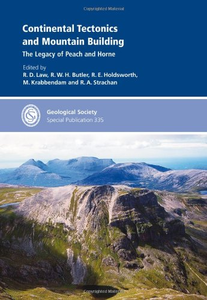Deformation partitioning, foliation successions and their significance for orogenesis: hiding lengthy deformation histories in mylonites
Bell, T.H. (2010) Deformation partitioning, foliation successions and their significance for orogenesis: hiding lengthy deformation histories in mylonites. In: Law, R.D., Butler, R.W.H., Holdsworth, R.E., Krabbendam , M., and Strachan, R.A., (eds.) Continental Tectonics and Mountain Building: The Legacy of Peach and Horne. Geological Society, London, Special Publications, 335 . Geological Society of London, Piccadilly, London, UK, pp. 275-292.
|
PDF (Published Version)
- Published Version
Restricted to Repository staff only |
||
![[img]](https://researchonline.jcu.edu.au/10927/2.hassmallThumbnailVersion/10927_Bell_Book_Cover_2010_.jpg)
|
Image (JPEG)
Download (46kB) |
Abstract
Although orogenesis commonly lasts 100 million years, a maximum of three foliations are usually preserved within any outcrop. They record little of the total history due to the effects of preferential partitioning of progressive shearing along S0. Such reactivation eventually destroys or rotates multiple successive foliations into parallelism with any layering that is present. Plate motion subjects a collisional orogen to spatially partitioned, episodic, but non-stop deformation. The bulk forces operating are horizontal and intermittently vertical (associated with gravitational load due to crustal thickening) forming sub-vertical and sub-horizontal foliations. These orientations are preserved in the strain shadows of anything competent that hinders reactivation of the compositional layering. Deformation partitioning results in portions of rock remaining unaffected for many events. Gravitational collapse of over-thickened orogen cores leads to significant extrusion in orogen rims and a dominance of sub-horizontal foliations in the latter and episodically continues throughout orogenesis. Reactivation causes decrenulation and/or rotation of foliations into parallelism with S0, destroying evidence that multiple sub-vertical and sub-horizontal foliations have developed except where preserved as inclusion trails in porphyroblasts and multiply truncated foliations in mylonites. However, the same processes operate in both the cores of orogens and ductile portions of their margins.
| Item ID: | 10927 |
|---|---|
| Item Type: | Book Chapter (Research - B1) |
| ISBN: | 9781862393004 |
| Related URLs: | |
| Date Deposited: | 11 Aug 2010 03:18 |
| FoR Codes: | 04 EARTH SCIENCES > 0403 Geology > 040312 Structural Geology @ 100% |
| SEO Codes: | 97 EXPANDING KNOWLEDGE > 970104 Expanding Knowledge in the Earth Sciences @ 100% |
| Downloads: |
Total: 1044 Last 12 Months: 4 |
| More Statistics |




